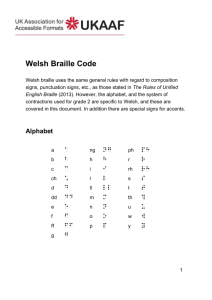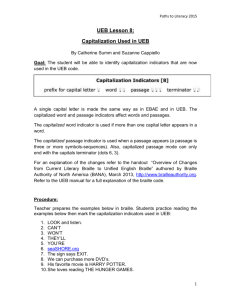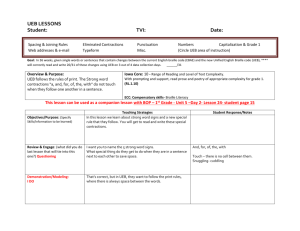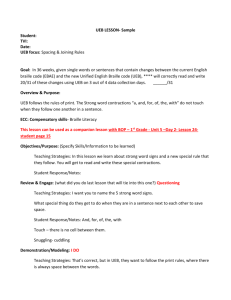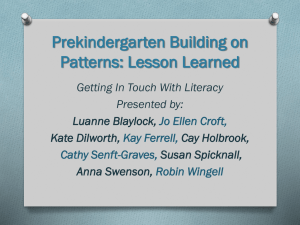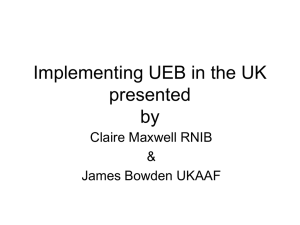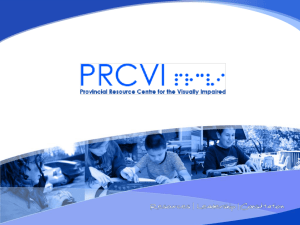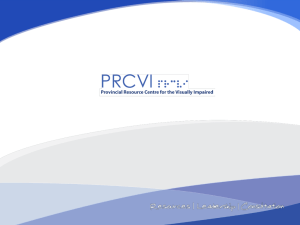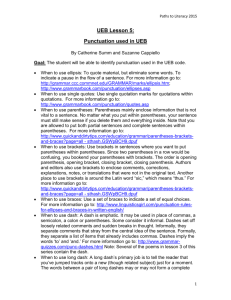104a
advertisement
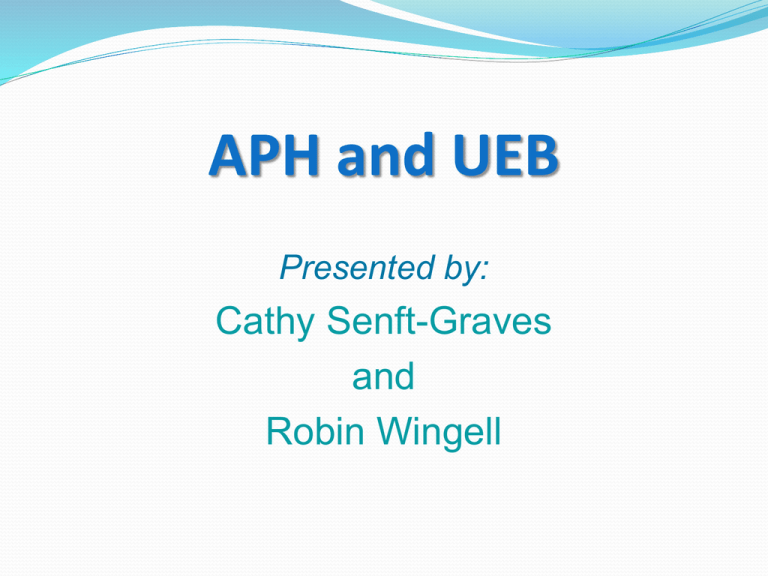
APH and UEB Presented by: Cathy Senft-Graves and Robin Wingell Agenda Introductions Policies regarding UEB Transition at the American Printing House for the Blind (APH) APH products which are or will soon be UEB compliant Plans for and progress on the revision of the Building on Patterns (BOP) curriculum Interim plans to incorporate UEB in BOP Steps Toward Transition November 2012: BANA adopts UEB October 2013: BANA’s first UEB Transition Forum chooses January 4, 2016 implementation date November 2013: BANA affirms implementation date July 2014: APH announces transition plan Policies Regarding UEB Transition at APH Orders for textbooks in subjects using literary braille (i.e., social studies and language arts), not previously transcribed, will be produced in UEB for the 2015-16 school year. Orders for textbooks in technical subjects (i.e., science and mathematics), not previously transcribed, will be produced in UEB and/or UEB with Nemeth Code for the 2015-16 school year. Textbooks previously transcribed will be available in their original codes, following APH’s policy of not duplicating previously transcribed textbooks and supplementary materials. Policies Regarding UEB Transition at APH APH will transcribe assessment materials in the codes requested by customers who contract with APH to make assessments accessible in hardcopy and/or refreshable braille. APH recognizes that assessment materials must be available in the code that is used most efficiently by each test taker (as indicated on his/her Individual Education Plan or 504 Plan). APH is committed to providing multiple formats for these high stakes assessments. Policies Regarding UEB Transition at APH APH will gradually transition instructional and assessment- related catalog products and materials to UEB and UEB with Nemeth Code throughout the next several years. Implementing UEB Transition at APH Braille Transcription All transcribers have completed or are in the process of completing the Australian UEB Online (AUO) course. Newly hired transcribers (approx. 6) are training with the AUO course and the NLS lessons made available this year. Proofreaders are training with the AUO course. Accessible Tests All personnel have completed or are in the process of completing the Australian UEB Online (AUO) course. Implementing UEB Transition at APH Accessible Textbooks All in-house personnel have completed the AUO course. All of the prison programs we are working with have either all completed a UEB course or have a plan to complete it by the end of May 2015. When we outsource new transcriptions, we request a copy of the transcriber’s UEB certification. Braille Transcribers Apprentice Program (BTAP) First transcriber starts in March, one more in June New Products Being Produced in UEB or UEB and Nemeth Emergent Literacy VIPS@Home: Power At Your Fingertips VIPS@Home: Emergent Literacy PAIVI (Parents and Their Infants With Visual Impairments) Second Edition Practitioners Manual PAIVI Learning Together booklet PAIVI Getting Ready for Preschool booklet New Products Being Produced in UEB or UEB and Nemeth Touch, Label, and Learn Poster: Human Skeleton (Anterior View) Instruction sheets for Nemeth Numbers Feel ‘N Peel stickers UEB Basic Math Symbols and Nemeth Basic Math Symbols All Aboard! The Sight Word Activity Express Building on Patterns, Prekindergarten Building on Patterns UEB Supplements Building on Patterns Revision Building on Patterns Only “basal reading series” for teaching braille reading and writing Building on Patterns Team External Writing Teams from Arkansas, California, and Oregon (All members of the writing teams are experienced teachers of students with visual impairments.) APH Staff Consultants to the program Building on Patterns 2nd Revision began immediately after completion of BOP 2nd Grade (original Patterns went through 3rd grade) Original intent to begin revising BOP Kindergarten Writers and consultants determined a need for Prekindergarten BOP to lead into Kindergarten based on state standards and checklists for Kindergarten entry Research to Support Need for Pre-K Program National Early Literacy Panel Report Common Core and Pre-K State Standards National Association for the Education of Young Children (NAEYC) Early Learning Standards Quality Literacy Instruction Study Current BOP-K Survey Current BOP-K Survey Online survey conducted 11/14/12 – 12/20/12 75 respondents from 22 states and the US Virgin Islands 97% of respondents TVIs Participants were asked: What is taught in BOP-K that should be taught in a pre-kindergarten early literacy program? BOP-K Survey Results: Teach Before Kindergarten When asked what is taught in BOP-K that should be taught in a Pre-K emergent literacy program, the top three responses were: phonemic awareness and phonics the alphabet, or an introduction to the alphabet contractions at least the first 12 lessons of BOP-K should be taught earlier. BOP-K Survey Results: Teach Before Kindergarten Other specific skills that received multiple mentions were: Tracking, reading with both hands Rhyming Introduction of braille cell Capital sign Period Spatial awareness/directionality: left to right; top, bottom, middle Concepts/concept development Tactile identification as fun activities Listening comprehension Vocabulary NELP Variables for Literacy Development Alphabet knowledge Phonological awareness Rapid Automatic Naming of letters or digits Rapid Automatic Naming of objects or colors Writing or writing name Phonological memory Quality Literacy Instruction Study Skill Areas Consistency Total Time per Day Time Span Duration Emergent Braille Literacy Skills 1 to 5 1/2 to days/week 1 hour Infancy to Preschool At least one school year Early Formal Literacy Skills ("prebraille") Daily 1/2 to 1 hour PreschoolAt least one Kindergarten school year Beginning Braille Literacy Skills Daily 1-2 hours per day Kindergarten- At least one Grade 3 school year Beginning Literacy Daily Skills in Dual Media (Print and Braille) 1-2 hours per day Kindergarten- At least one Grade 3 school year Project SLATE /Framework for Braille Professional Consensus on Instructional Considerations for Students in Braille Literacy Programs Koenig, A. J., & Holbrook, M. C. (2000). Assuring quality literacy instruction in braille literacy programs. Journal of Visual Impairment and Blindness, 94(11), 677-694. Need for BOP Pre-K BOP-K survey confirmed a need for Pre-K braille literacy material Pre-K will be a separate curriculum as is available in general education programs Maryland Common Core State Curriculum Frameworks for Braille includes Pre-K skills Keeping pace with peers: many entering kindergarteners recognize letters & numbers, read and write their names Selected BOP Principles BOP will be a part of a comprehensive program Importance of consistent literacy instruction from qualified TVI Service delivery is diverse Literacy instruction should be evidence-grounded and on-going research should be conducted Value of authentic literature Concept development through literacy instruction Connections to the ECC Students have individual needs, likes and dislikes Components of BOP Pre-K Reading and Writing Braille Letters and Numbers Reading and Writing Simple Connected Text Dialogic Reading with Authentic Literature Comprehension and Vocabulary Phonological Awareness and Phonics Knowledge and Concept Development Tactile Skills, including Graphics Purposes of Pilot Field Test Ask for feedback from Pre-K teachers on Lessons 2, 3, and 4 Get video examples of Pre-K children working through parts of lessons Check length of lessons and activities within lessons Gather information about service delivery impact on completion of lessons Our Pilot Testers 3 sites Kentucky, New Mexico, and Florida 2 service delivery models Center based and Itinerant Participants 7 teachers and 7+ children Key Findings Stories (trade books) are interesting but some are a little long; children responded more (and better) to the second reading of the book Vocabulary words—good balance between simple and challenging words Comprehension—these young children had some difficulty with “open ended” questions and questions that asked children to “personalize” something in the story Key Findings (continued) Children have difficulty producing written work on the braille writer (Perkins) but teachers saw value in ongoing practice to encourage finger strength, finger isolation and span [writers are including consistent practice in lessons] Largest issue was lesson length and consistency. Writers have made major changes to plans for the lessons that addresses these concerns Children liked songs and other enrichment activities (The Wheels on the Bus; art projects) Key Findings (continued) Children liked the Tactile Storybooks Discovered issues that need to be addressed in some way: Rhyming Words Comprehension Questions Introduction of the Swing Cell Enjoyment of tactile graphics symbols Teachers reported that even if their student has trouble with some things (e.g., finger strength) it is good to work on them Pre-K Changes Based on Field Testing BOP Pre-k writers have reviewed results of the pilot field test and are working to: Shorten and/or reduce the number of activities within the lesson Decrease the length of the curriculum by shortening the length of review and assessment lessons Attend to needed practice in areas of concern to teachers In Every Lesson Reading of Authentic Literature Story Comprehension and Vocabulary Tactile Storybook Writing: Practice Exercises and Modeled/Interactive Phonological Awareness Knowledge and Concept Development Letter Recognition and Phonics Number Recognition Reading Continuous Text Additional Lesson Features Daily reading of alphabet Regular reading of numbers 1-10 Enrichment: Music Other enrichment activities such as art or movement Parent Letter Letter Bank Authentic Literature Pete the Cat and His Four Groovy Buttons by Eric Litwin Vocabulary groovy: really cool; great; awesome favorite: the one he liked best popped: came off or fell off buttonless: without buttons, no buttons Tactile Storybook Cover: Pete’s Buttons Tactile Storybook Page #a 3333 = 333 = 3333 = 333 = 33 3333333333333333 #d 33333333 333333333 pop 33333333333333 Fun Learning Activities! Field Testing APH uses the comments and recommendations gathered from experts in the field to refine and improve products before actual production. Complete form available at: http://www.aph.org/edresearch/ Contact Laura Zierer, Research Assistant, lzierer@aph.org Building on Patterns UEB Teacher Supplements and Updated Student Materials Components Student textbooks and worksheets in UEB Posttest materials for First Grade and Second Grade in UEB Free, downloadable supplements for the existing teacher’s editions with information on what changes for UEB Changes Being Made Now Stopped production of student materials in old code Retranslating student materials in UEB as needed Only 4 pages in one BOP Kindergarten book changes Student Textbooks for Units 1 and 2 of First Grade do not change All worksheets in First and Second Grade change due to page numbering (WS24-6 is now ,,ws#bd-#f) Writing teacher supplements Teacher Supplements Content Introductory page of information How to read the charts General changes not listed in the charts Chart of changes for each Lesson Page number in Teacher’s Edition (TE) Location: Where on page in TE, or Student Textbook page number, or Worksheet page number Description of change Additional location information and type of change GRADE 1: UNIT 5, LESSON 25 Location TE / WS / ST TE Page Change Sentence Spacing Rule Omissions 61 ST 19 last line with a 62 ST 20 line 5 for a 66 WS25-3 #4 of the / with the 72 ST 24 last line and a 73 ST 25 line 1 of the ST 25 line 2 of the ST 29 line 5 and a 77 78 ST 30 UEB does not have a contraction for "com." ST 30 87 WS25-8 line 2 line 2 UEB does not have a contraction for "to." come: com omitted #3 for a to Ordering Taking fax orders for new kits and student materials for Kindergarten and First Grade levels Orders have to be accompanied by Federal Quota Funds Order Form (APH website) Asking for orders to be placed by April 15 Kits will now be “student kits”; teacher’s editions sold separately First and Second Grade Posttests will also be updated to UEB; only asking for orders on First Grade Posttest at this time Questions? Please Consider Field Testing! APH uses the comments and recommendations gathered from experts in the field to refine and improve products before actual production. Complete form available at: http://www.aph.org/edresearch/ Contact Laura Zierer, Research Assistant, lzierer@aph.org
